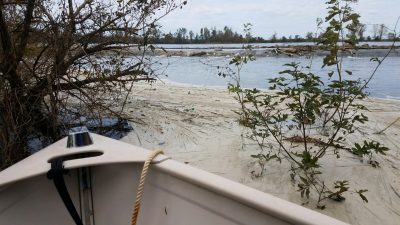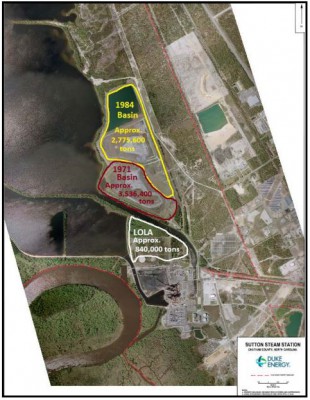
This story has been updated to include a response from Duke Energy.
The Trump administration moved last week to rewrite part of Obama-era regulations addressing coal ash disposal, which entails risks that a Duke University researcher says are all too familiar in coastal North Carolina.
Supporter Spotlight
But a Duke Energy spokesperson said the proposed changes will have no effect on the utility’s handling of the residuals from coal-fired power plants and ongoing closure of coal ash basins. And the utility said Tuesday the researcher is distorting the facts surrounding coal ash at the its Wilmington facility.

The Environmental Protection Agency announced Nov. 4 proposed changes to the 2015 regulation of how electric utilities manage their coal combustion residuals, or CCRs, which are also known known as coal ash, fly ash, bottom ash and boiler slag, and guidelines for handling effluent from steam electric power plants.
“Today’s proposed actions were triggered by court rulings and petitions for reconsideration on two 2015 rules that placed heavy burdens on electricity producers across the country,” said EPA Administrator Andrew Wheeler in the announcement.
In 2015, the EPA had hailed the rule as the first national regulation covering the leaking of coal ash-related contaminants into groundwater, the blowing of contaminants into the air as dust and the catastrophic failure of coal ash impoundments. The rule also set out record-keeping and reporting requirements and mandated each coal ash facility to post information to a publicly accessible website.
The EPA said the rule was the culmination of extensive study on the effects of coal ash on the environment and public health. But there is no scientific merit for the current administration’s regulatory rollback, said Avner Vengosh, a professor at Duke’s Nicholas School of the Environment, whose research focuses on the environmental implications of coal ash disposal and storage.
Supporter Spotlight
Together with his students and colleagues Vengosh has been researching coal ash and its environmental effects for about 10 years.
Vengosh told Coastal Review Online that the EPA’s latest decision goes beyond just kowtowing to the industry.

“It’s even more than that. It means that the cost (of contamination and cleanup) is going to be moved to the public, rather than being covered by the industry. I think that is something that the people are not really understanding,” Vengosh said.
The proposed changes would set a new date of Aug. 31, 2020, for facilities to stop placing coal ash into unlined surface impoundments and impoundments located near aquifers or to retrofit them.
Vengosh said any delays of deadlines would lead to more and worsening problems as the companies responsible for the pollution are granted more time to potentially fold, go bankrupt or otherwise avoid their responsibility.
“So, by the end of the day the public will have to deal with it rather than the industry. They’re basically saving the industry from their own doing,” he said. “It’s sad that EPA became so political.”
Vengosh submitted written comments opposing the rule change, saying that his motivation to get involved was related to his scientific research on the environmental implications from coal ash disposal and storage. “Together with my students and colleagues at Duke University, I have been conducting research on the subject of coal ash and its environmental effects for about ten years,” Vengosh wrote.
His research projects have included investigation of the environmental effects of the Tennessee Valley Authority coal ash spill in Kingston, Tennessee; sources of mercury in river sediments from TVA spill sites; discharge of effluents from coal ash impoundments to waterways in North Carolina; developing isotope methods to detect coal ash contaminants in the environment; leaking of coal ash ponds in the Southeast; radioactivity of coal ash; possible links between hexavalent chromium and coal ash ponds in North Carolina; and leaching of arsenic and selenium from coal ash.
“Overall, I have published 13 scientific articles on different aspects of the environmental effects of coal ash,” Vengosh wrote.
Vengosh said the EPA’s proposal would considerably weaken existing federal regulations, reducing environmental protection and safeguards, and severely exacerbate environmental effects associated with coal ash storage and disposal.
He said the changes would undo important safeguards in the 2015 Coal Ash Rule, including the required comprehensive and long-term monitoring of groundwater in the vicinity of coal ash impoundments, including those no longer in use. The changes would allow states to set different standards for coal ash contaminants in groundwater and make groundwater quality and air quality data less transparent.
Also, the proposal would “backtrack” from the 2015 rule’s requirement that the operators of unlined coal ash ponds in areas where there’s contamination of underlying groundwater install liners or close the storage ponds by a certain date. The proposed amendments would allow state agencies or utilities themselves to decide on closure or installation of liners and make the now-required cleanup of contaminated groundwater “discretionary.”
All coal ash ponds are located near major rivers. That’s because water is needed as a coolant for coal-fired plants, so all coal plants and their coal ash facilities are near waterways.
Vengosh said research, his and others’, has shown that nearly all coal ash ponds leak and contaminate the underlying groundwater and nearby surface water. “Basically, everywhere there is a coal ash pond there is leaking – period,” he said.
He authored a 2016 study that looked at archived water chemistry data from 156 wells monitoring groundwater below all 14 coal ash ponds in North Carolina between 2010 and 2015. The evidence suggested that closing coal ash ponds does not necessarily eliminate the leaking of contaminated water from ponds to the environment.
Coal Ash in the Cape Fear
The coal-fired units at Duke Energy’s Sutton Plant in Wilmington were retired in 2013, when the utility switched to natural gas-fired generation, and the coal units were demolished about four years later. And the utility says that during the first half of this year, it completed excavation of the ash basin at the plant and two others in North Carolina, Dan River Steam Station in Eden and Riverbend Steam Station in Mount Holly.

But during Hurricane Florence in 2018, rising water levels in the Cape Fear River breached the plant’s cooling lake, known as Sutton Lake, flushing its contents into the river. In the days following the storm, Duke Energy said water samples from upstream and downstream of the site showed “little to no impact to river water quality” and all results were “well within” state water quality standards.
“There is little difference in river water quality when comparing samples taken upstream above the facility and downstream below the facility,” the utility announced, sharing its test results online.
The 1,100-acre lake is open to the public and the state Wildlife Resources Commission manages a boat ramp there.
Vengosh in June published a paper that concluded there was evidence for multiple spills of coal ash into Sutton Lake, with concentrations of metals that far exceeded state regulations for freshwater lakes. Also, tissue from fish in lake – a popular fishing spot for nearby residents – contain an isotope fingerprint of coal ash, he said.
“Sutton Lake represents a case where the handling of coal ash near drinking water or freshwater resources is causing the mobilization or transport of coal ash into the lake and contamination of the lake. Sutton Lake is really kind of an example of why the 2015 ruling is so important,” Vengosh said.
A Duke Energy spokesperson said in June that Vengosh’s findings were not unexpected and not relevant to anyone’s health and that the wastewater facility performed as designed, serving as a buffer between the coal plant and the Cape Fear River to protect the public and the environment. The company also produced a graphic that noted that levels of selenium, which is often associated with coal ash, in Sutton Lake were far below the state’s recreational human consumption advisory level.
“To me, this was stunning, because they never said it before and the fact that they admitted they put coal ash into the recreation lake, it’s crazy, and I’m actually stunned why nobody sues them,” Vengosh said.
In a response Tuesday, Duke Energy rejected the notion that it had intentionally put coal ash in the lake and dismissed Vengosh’s conclusions.
“Vengosh’s blatant misrepresentation of our statements about Sutton Lake is irresponsible. We operated the Sutton facility in compliance with all permits and approvals and transparently communicated that the Sutton cooling pond was permitted to receive wastewater discharges from the retired steam station, which may have included trace amounts of CCR. This is very different from his previous speculation that we have had significant unreported releases of coal ash into the lake, followed by his implication that we intentionally ‘put’ ash into the lake – an accusation of wrongdoing and a shocking distortion of the facts. Vengosh’s latest fabrication – and subsequent speculation based on a fabrication – is yet another example in a recurring pattern of him seeing things he wants to see and leaping to conclusions not based on facts,” Duke Energy said.
Vengosh said concentrations of coal ash-related metals in Sutton Lake bottom sediment were higher than those measured after the TVA coal ash spills and higher than the Dan River coal ash spill in North Carolina.
“People living in the area should be shocked,” Vengosh said. “It’s not the putting of coal ash into a pond that’s designated for coal ash only, it’s putting coal ash into a lake that’s used by the public. Maybe it’s not unique to Sutton Lake, but we don’t know.”
Bill Norton, the Duke Energy spokesperson, said Thursday that the proposed EPA rule changes would not affect the utility or its Sutton Plant.
“While we are still reviewing EPA’s proposal, we do not expect Duke Energy will be impacted because we are already far down the path of closure,” Norton said.
Norton also disagreed with the conclusions Vengosh and his colleagues reached.
“Their paper was fundamentally flawed for a number of reasons, in particular because it made broad generalizations, assumptions, and conclusions based on an inadequate study design and a very small, limited data set. It appears that the authors had a conclusion in mind before going through a full and robust research process,” Norton said.
He said decades of fish tissue tests of catfish, sunfish and black bass for selenium, the primary tracer used to detect potential influences from coal ash, have consistently demonstrated selenium levels far below the state’s rigorous recreational human consumption advisory level.
“In regard to flooding, even after Hurricane Florence’s historic storm, several days of testing – including split samples with the state – showed results well within rigorous state water quality standards. Even inside Sutton Lake immediately after the storm, the results for coal ash constituents were well within the strict water quality standards that protect people and the environment,” Norton said. “Most importantly, nearly 40 years of rigorous study and sampling proves the fish are thriving and the lake remains safe to use for recreation purposes like fishing and boating.”
No effect on closure plans
Norton said the proposed CCR rule changes will not impact Duke Energy’s timelines for closure.
“We made the commitment to close all coal ash basins across our system, and that is unchanged. We holistically planned upgrades to safely manage coal ash and comply with both state and federal regulations. Those upgrades included dry ash handling systems, new wastewater treatment systems and new lined landfills. That work was necessary to take ash basins out of service,” Norton said.
Norton described the Sutton site as an example of the company’s progress. Duke Energy completed excavating the coal ash basins at its Sutton facility in June.

“We continue to excavate a small quantity of ash from a low-lying area adjacent to the original plant site, and that work is expected to be complete in the coming months,” Norton said, adding that the utility’s groundwater monitoring will continue with no change in public access to the data from the resulting data.
“In addition to federal compliance, all our work must comply with very strict state groundwater and surface water standards designed to keep the public and environment safe,” Norton said.
Separately, Duke Energy continues to appeal a decision earlier this year by the North Carolina Department of Environmental Quality requiring its nine remaining unlined coal ash basins on Lakes Norman and Wylie, on the Broad River, and in Stokes and Person counties to be closed by excavation. Duke Energy is challenging the timing of the state’s mandate, saying that DEQ has chosen the most expensive, disruptive and time-consuming closure option for several basins without measurable benefit when compared to other approaches and ignoring the costs that customers will bear. The Southern Environmental Law Center is representing more than a half-dozen community groups opposing Duke Energy in the Office of Administrative Hearings proceedings.








